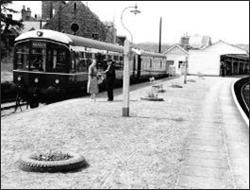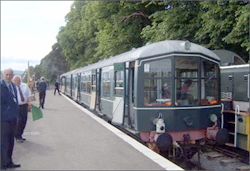
A few years ago, my cousin Martha Dees (known to the family as Marty) researched the family tree back some 14 generations to our 12th great-grandfather who left the ancestral home in Scotland to come to the new world. The region just southwest of Aberbeen, is known as Deeside and is along the River Dee – hence the basis for our last name. The area is rich in history, is the site of the Royal Bayoral Castle, and includes an interesting and very active historical railway group – the Royal Deeside Railway.
The story of the Royal Deeside Railway dates back to 1845, when the prospectus for the Deeside Railway was issued. This was to be a single-line railway from Aberdeen to the town of Banchory, following the north side of the Dee river throughout. The scheme was so well received that it was decided to extend the line from Banchory through Kincardine O’Neill to Aboyne, just over 29 miles from Aberdeen.
Authorized on 16 July 1846, the Deeside Railway was delayed by the construction of the Aberdeen Railway from Forfar, and the scheme was re-authorized on 28 May 1852, although the Aboyne extension was postponed to a later date. The Deeside Railway opened to traffic on 8th September 1853. Eventually the line was extended to Aboyne in 1857 and reached Ballater on 17 October 1866.
Amalgamated with the Great North of Scotland Railway by 1876, the Deeside Railway was one of the region’s most scenic railway lines and for many years was travelled by members of the Royal Family en route to Balmoral Castle. Indeed, Queen Victoria’s desire for privacy at Balmoral Castle was the reason why the Deeside Railway never continued as planned to Braemar at the top of the Dee Valley.
Although the Deeside Railway was one of the most scenic and picturesque lines in the Aberdeenshire area, the line was mentioned in the Beeching Report of 1963 as a loss-making railway, closing to passengers on 28th February 1966. Goods traffic to the Culter Paper Mills kept the line open for freight until 30 December 1966, when Class B1 Steam Locomotive No. 61180 became the last steam train to run on the Deeside Railway. Arnott Young Ltd. were given the task of dismantling the line and by 1972 the tracks of the Deeside Railway had been lifted.
From 1972 the route of the railway slowly began to be reclaimed by nature, although the former trackbed, station buildings and bridges remained clearly visible to the public. Over time portions of the route were converted for other uses, the trackbed between Holburn Street & Culter being surfaced as a popular cycle & walking route. Other changes were more dramatic, such as the removal of the Holburn Street Bridge in 1981, the demolition of the station site at Banchory for construction of housing, and the complete dismantling of the Blarnacrag (or Beltie) Viaduct between Torphins & Lumphanan. However the majority of the route is still easily visible some 40 years after the railway was closed.
The Royal Deeside Railway Preservation Society was formed in 1996 by local railway enthusiasts, initially concentrating its efforts at the Aberdeen end of the line, where part of the former Aberdeen Ferryhill Engine Shed was considered for use as a workshop & museum, along with heritage railway services on the section of former Deeside Railway trackbed adjacent to the shed site. Discussions on the acquisition of the shed site are continuing with Network Rail & Aberdeen City Council.

In August 2000 the society submitted plans to the local council for a reinstated railway operation between Banchory and Milton of Crathes, on the former Deeside Railway Line. Recent European Legislation required an “Environmental Impact Assessment” to be carried out, which was submitted in 2002. Approval for the majority of the scheme was received on 10th June 2003, work starting at the Milton end shortly thereafter.
The Society now has a number of items of rolling stock under restoration, including the unique “Battery Railcar” which ran on the line in the 1950s, and a historic collection of vintage Victorian coaches which are under restoration for use on the line. Regular summer execursions were started in 2008 and already the railway is beginning to come back to life.
Website address: http://www.deeside-railway.co.uk/index.php
